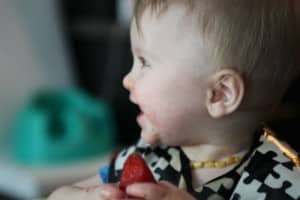To read the previous part, go to When to Feed the Baby.
Updated article : April 2024.
There are many foods to start with in your baby’s diet. While no formal introduction order exists, here are a few rules to guide you through this important transition stage for your child:
- Continue breastfeeding for as long as possible. It’s a complete food for your baby up to six months. Then add foods to breastfeeding. For babies fed with formula, you should also start solid foods at six months, or between four and six months depending on the situation;
- Never introduce solid foods before four months (when in doubt consult a health professional);
- Always introduce one new food at a time. Give it to your baby three to five times in a row to see if they have an allergic reaction. Then you can mix it with another food or introduce another. Examples of allergic reactions are red rashes on the body, vomiting, increased body temperature, diarrhea, cramping with intense crying;
- Between four and six months, purées with single baby cereals enriched with iron, fruits and vegetables (consult our solid food introduction table). A typical day can be a morning meal with cereal and fruit, lunch with vegetables and for dinner fruit and cereal with vegetables and fruit to end the meal. Of course, the child will also consume milk with these other foods;

- At six months, quickly add foods that are high in iron, like meats, mixed cereals, eggs, tofu, legumes and fish to prevent newborn anemia. Based on your baby’s motor skill development (if they crawl for example), shift progressively from smooth to softer, pastier purées. Then shift to purées with small pieces to get them used to different textures. When they start walking, you can give them foods that are chopped into bigger pieces. They can pick them up with the fingers, put it in their mouth and chew it. A typical day could look like a breakfast of cereal (don’t use multi-grain cereals such as Nature’s Path because they’re too hard for the baby to chew) and fruit, lunch with meat, vegetables and fruit. Do the same for dinner (the meat at dinner replaces the 2nd portion of cereal), with breastfeeding or bottle between (consult the solid food introduction table in PDF format found in the tool box at mariefortier.com);
- Dairy products, such as cheese and yogurt, can be added when the baby eats an iron source twice a day (cereals, meat, eggs, fish, legumes);
- You shouldn’t give them 3.25% milk before nine months unless they eat from all the food groups, they are allergy-free, and their growth curves are as expected for their normal development and growth. The quantity should never be more than 750 ml a day up to two years of age. After two, the baby can continue with this milk or shift to 2%. But never 1% or skim because the baby needs fat for their development;
- It’s also recommended avoiding processed meats, such a ham, sausages, salami, and bacon because they have no nutritional value and contain high levels of nitrites, nitrates, salt and fat. Nothing healthy for you or your baby. Don’t forget that if you eat prepared meals, the salt quantity is often very high. You shouldn’t give these to your baby before they’re one year old.
- Fish can now be given to a baby from six months, and is a good source of iron, vitamin D, protein and good fats for the baby. For example, you can use salmon, trout, haddock, tilapia and cod. Never serve them raw or smoked fish. Parasites found in the fish meat can be harmful for the baby’s underdeveloped system;
- At six months you can start giving them whole eggs as long as they’re hard-boiled and the yolk is fully cooked. Eggs are nourishing. If the baby has a reaction, you need to consult your doctor to test them for other possible food allergies.
- It’s now okay to use cooking water with nitrates from certain vegetables, such as carrots, turnips, beets and spinach. You no longer have to throw it away, it would not be risky for a baby over 3 months of age, so there’s no need to worry about introducing it (source : INSPQ 2024).
To see some ideas about a daily food schedule, go to the next article Daily Meal Schedule.


